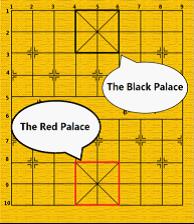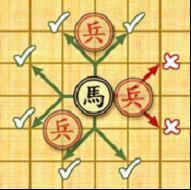题意 给你一个黑方被将军的象棋残局 判断红方是否已经把黑方将死
模拟题 注意细节就行了 看黑方的将是否四个方向都不能走
#include<cstdio>
#include<cstring>
using namespace std;
const int N = 12;
char brd[N][N];
int dx[] = { -1, 1, 0, 0}, dy[] = {0, 0, -1, 1};
int hx[] = { -2, -1, -2, -1, 1, 2, 1, 2}; //马将军
int hy[] = { -1, -2, 1, 2, -2, -1, 2, 1};
int tx[] = { -1, -1, -1, -1, 1, 1, 1, 1}; //马蹩脚
int ty[] = { -1, -1, 1, 1, -1, -1, 1, 1};
int cr[2], cc[2]; //记录炮的坐标
int check(int r, int c)
{
int i, j, k, tr, tc, cnt;
if(r < 1 || r > 3 || c < 4 || c > 6) return 1;
for (j = c - 1; j > 0; --j) //行被车
{
if(brd[r][j])
if(brd[r][j] == 'R') return 1;
else break;
}
for (j = c + 1; j <= 9; ++j)
{
if(brd[r][j])
if(brd[r][j] == 'R') return 1;
else break;
}
for (i = r - 1; i > 0; --i) //列被车
{
if(brd[i][c])
if(brd[i][c] == 'R') return 1;
else break;
}
for (i = r + 1; i <= 10; ++i) //列被车或将
{
if(brd[i][c])
if(brd[i][c] == 'R' || brd[i][c] == 'G') return 1;
else break;
}
for(int k = 0; k < 2; ++k) //被炮将军
{
if(cr[k] == r) //行有炮
{
for(j = c - 1, cnt = 0; j > cc[k]; --j) if(brd[r][j]) ++cnt;
if(cnt == 1) return 1;
for(j = c + 1, cnt = 0; j < cc[k]; ++j) if(brd[r][j]) ++cnt;
if(cnt == 1) return 1;
}
if(cc[k] == c) //列有炮
{
for(i = r - 1, cnt = 0; i > cr[k]; --i) if(brd[i][c]) ++cnt;
if(cnt == 1) return 1;
for(i = r + 1, cnt = 0; i < cr[k]; ++i) if(brd[i][c]) ++cnt;
if(cnt == 1) return 1;
}
}
for(int k = 0; k < 8; ++k) //被马将军
{
tr = r + hx[k], tc = c + hy[k];
if(tr < 1 || tr > 10 || tc < 1 || tc > 9) continue;
if(brd[tr][tc] == 'H' && (!brd[r + tx[k]][c + ty[k]]))
return 1;
}
return 0;
}
int main()
{
char s[5];
int n, r, c, x, y;
while(scanf("%d%d%d", &n, &r, &c), n || r || c)
{
memset(brd, 0, sizeof(brd));
cr[0] = cc[0] = cr[1] = cc[1] = 0;
while(n--)
{
scanf("%s%d%d", s, &x, &y);
if(s[0] == 'C')
{
if(cr[0]) cr[1] = x, cc[1] = y;
else cr[0] = x, cc[0] = y;
}
brd[x][y] = s[0];
}
int cnt = 0;
for(int i = 0; i < 4; ++i)
cnt += check(r + dx[i], c + dy[i]);
if(cnt < 4) puts("NO");
else puts("YES");
}
return 0;
}

 General: the generals can move and capture one point either vertically or horizontally and cannot leave the “palace” unless the situation called
“flying general” (see the figure above). “Flying general” means that one general can “fly” across the board to capture the enemy general if they stand on the same line without intervening pieces.
General: the generals can move and capture one point either vertically or horizontally and cannot leave the “palace” unless the situation called
“flying general” (see the figure above). “Flying general” means that one general can “fly” across the board to capture the enemy general if they stand on the same line without intervening pieces. Chariot: the chariots can move and capture vertically and horizontally by any distance, but may not jump over intervening pieces
Chariot: the chariots can move and capture vertically and horizontally by any distance, but may not jump over intervening pieces Cannon: the cannons move like the chariots, horizontally and vertically, but capture by jumping exactly one piece (whether it is friendly or enemy) over to its
target.
Cannon: the cannons move like the chariots, horizontally and vertically, but capture by jumping exactly one piece (whether it is friendly or enemy) over to its
target. Horse: the horses have 8 kinds of jumps to move and capture shown in the left figure. However, if there is any pieces lying on a point away from the horse horizontally or vertically
it cannot move or capture in that direction (see the figure below), which is called “hobbling the horse’s leg”.
Horse: the horses have 8 kinds of jumps to move and capture shown in the left figure. However, if there is any pieces lying on a point away from the horse horizontally or vertically
it cannot move or capture in that direction (see the figure below), which is called “hobbling the horse’s leg”.
2 1 4 G 10 5 R 6 4 3 1 5 H 4 5 G 10 5 C 7 5 0 0 0
YES NO
原文:http://blog.csdn.net/acvay/article/details/42917157